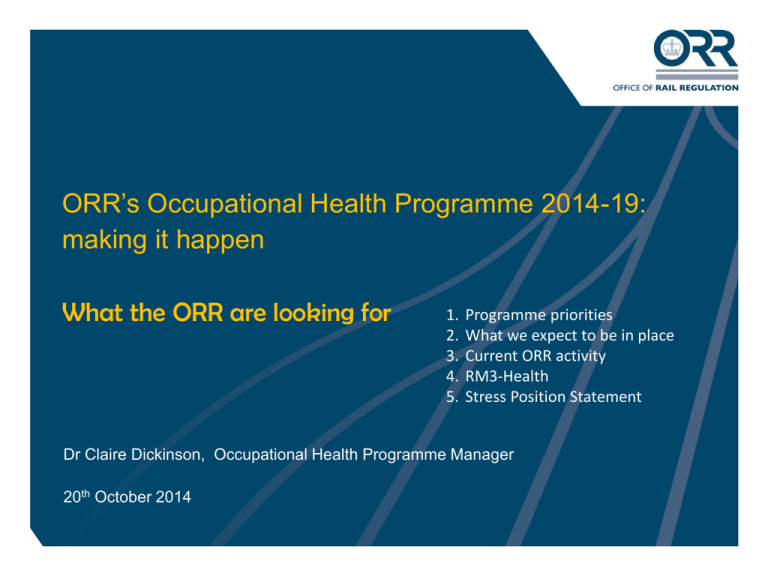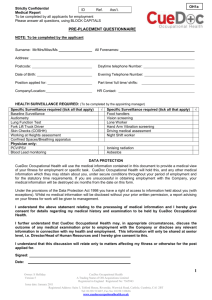ORR’s Occupational Health Programme 2014-19: making it happen
advertisement

ORR’s Occupational Health Programme 2014-19: making it happen What the ORR are looking for 1. 2. 3. 4. 5. Programme priorities What we expect to be in place Current ORR activity RM3-Health Stress Position Statement Dr Claire Dickinson, Occupational Health Programme Manager 20th October 2014 1 2nd Programme published 28th April 2014 4 E’s Scope : Whole rail industry Builds on the first programme Key focus : securing legal compliance “Assist and encourage” - Collaborative approach, including Trade Union’s Enforcement notices : 22 Measure the capability of health management systems using RM3-H RC6 published July 2014 2 Pages 10 & 11 - priorities Proactively managing health risks: hand-arm vibration, stress, musculoskeletal disorders, effective risk assessments with identifiable controls, health surveillance and RIDDOR Implemented health policy ; senior commitment, resources, continuous improvement Sign up as partners to the Responsibility Deal Drive innovation in health risk management by better use of specialist resource, implementing NICE guidance or promoting physical activity Pursue the activities of the RSSB Industry Roadmap Pursue early intervention on musculoskeletal disorders and demonstrate good practice in management of trauma Improve the use of good health data, develop trend & comparators 3 Pages 10 & 11 - priorities Work openly with trade unions Share good practice on what works…ORR website Be aware of costs, “at least as good as comparators” Raise awareness and competence on health risk assessment – Participate in the EUOSHA European Week for Safety & Health at Work – October 2014 Raise the standard of passenger experience and satisfaction on perceptions of health risks and cleanliness 4 Accent Report : feedback “Health like Safety” When asked what is missing or can be improved, the key responses were: 5 • More strategic approach • More collaborative working Making It Happen ! Ballast Dust Asbestos management Manual Handling of concrete troughing Spraying isocyanate paint 6 What we expect to be in place …. Silica Dust COSHH, 2002 7 PP3 Mask & clean shaven Avoid being present Facefit testing by accredited group Engineering Controls Health Surveillance Water Suppression Site Specific Risk Assessment Dust Monitoring Info/Training Silica.…minimum standards at work sites Systems of work – keep clear if not required Minimise drop heights for unloading ballast Operators in cabs – all to keep windows/doors closed; H-type filters and door seals on OTMs with a/c. Maintenance of controls – including equipment but also checks on systems of work 8 Silica….use of RPE & health surveillance RPE P3 standard, worn properly (clean shaven) Face fit tested, with written records Compatible with other PPE and communications Tight fitting RPE not suitable where significant exposure and worn > 1 hour Health surveillance for workers at significant risk to detect early signs of disease 9 What we expect to be in place …. Asbestos Control of Asbestos Regulations, 2013 Survey & Testing to assess whether asbestos present Notify enforcing authority / License Prevent or reduce exposure, & PPE Information, Instruction & Training Engineering Controls e.g. Enclosure, Showers Air monitoring Deploy appropriate work processes , eg vacuum not brush Health Records & Medical Surveillance Monitoring condition of asbestos 10 Extent of asbestos risk & Asbestos Plan Manual handling risks : Avoid, Assess, Reduce Manual lifting and carrying heavy concrete troughing sections– C143 prohibited. Delivery by RRVs; use of lightweight concrete or composites – detail in HSL report Welding sets from site access point onto track 11 Paint Spraying of Trains: 12 isocyanate paint fume RIDDOR, 2013 RIDDOR, 2013 – introduction of Reg 8 & 9 The list of reportable occupational health conditions is shorter comprising 6 short latency occupational conditions carpal tunnel syndrome, cramp in the hand or forearm, hand arm vibration syndrome (HAVS), tendonitis or tenosynovitis in the hand or forearm, occupational asthma, and occupational dermatitis. In addition, any occupational cancers (due to exposure to carcinogens as defined under COSHH), and diseases attributable to occupational exposure to a biological agent Report for conditions that are “new / significantly worsened” 13 Reporting on NRT Portal : From July 2013 https://dataportal.orr.gov.uk/ Data from SMIS (mainline) and LUSEA (TfL) for: manual handling injuries and shock/trauma incidents from 2005 to 31/3/2014. RIDDOR reports from April 2010 to March 2014 14 RIDDOR Reporting on the NRT Portal : July 2014 Disease Type 2010-11 2011-12 2012-13 2013-14 Carpal tunnel syndrome 4 0 2 2 Cramp in the hand or forearm due to repetitive movements 0 0 2 0 Hand Arms Vibration Syndrome (HAVS) 34 95 97 76 Legionellosis (infectious disease due to biological agents) 0 0 0 0 Leptospirosis (infectious disease due to biological agents) 0 1 3 0 Occupational asthma 0 0 0 1 Occupational cancers 0 0 0 0 Occupational dermatitis 1 0 0 0 Tendonitis or tenosynovitis in hand or forearm 1 1 0 0 15 HAVS – what we expect to see Routes to develop HAVS risk improvement plans (mandated by NR HQ) Focus on higher risk tasks – needle guns, rail grinders, impact wrenches, rotary hammer drills – some trigger times < 15mins to ELV Managing HAVS exposure by Task design – avoid need hand held or guided vibrating tools; automate Lower vibration tools – purchase/hire policies; updated Small Plant and Tool datasheets with trigger times; Geismar MP12 grinders to retrofit vibration reducing handles Assessing and managing personal exposures 16 Occupational Cancers : DEEE, Silica & Asbestos • Revised RGD guidance for Inspectors on DEEE and silica in preparation • COSHH, 2002 duties re DEEE – robust precautionary approach • Assess exposure to DEEE/ Prevent and Control consistent with hierarchy of control • High exposures to nitrous oxide in busy station areas/ Para 15-Elemental Carbon as marker • Silica – keep away, reduce dust, health surveillance, PP3 face masks, face fit testing regime 17 Repeat of the ORR baseline review http://orr.gov.uk/what-and-how-we-regulate/health-and-safety/monitoringand-reporting/occupational-health-assessment • HSE Labour Force Survey Data • ORR Quantification Survey • Information & Intelligence from: • Inspections • Annual Return • Industry Reports • Due to be published June 2015 18 HAVS / MSD / Asbestos / Stress Position Statements Updated Strategic Risk Priorities Document Chapter 9 19 Mandatory Investigations & RGD 2010-10 Case of legionnaires disease where the source of infection may be on a railway location enforced by ORR Suspension from work due to high blood lead levels Occupational asthma, …isocyanate paint as respiratory sensitizer Plus, RGD 2010-10 Matters of Evident Concern – conditions that pose a serious risk of ill-health – old pipework - legionella 20 Quarterly occupational health programme updates http://orr.gov.uk/what-and-how-we-regulate/health-and-safety/monitoring-andreporting/occupational-health-quarterly-updates 21 RM3 – Health Information on web Example for stress Pilot at TPE & CrossCountry http://orr.gov.uk/what-and-howwe-regulate/health-andsafety/monitoring-andreporting/occupational-healthand-the-railway-managementmaturity-model 22 RM3 Radar Plot RM3 assessment comparison 2010/11 with 2011/12 Leadership - SP1 Corrective Action / Change… Safety Policy - SP2 Review at appropriate levels - MRA4 Board Governance - SP3 Incident investigation and… Audit - MRA2 Proactive monitoring arrangements -… Emergency Planning - RCS5 Control of contractors - RCS4 Change management (process,… Asset management (including safe… Safe systems of work including safety… Written Safety Management System… Allocation of responsibilities - OC1 Management and supervisory… Organisational structure… Communication arrangements - OC4 System safety and interface… Culture management - OC6 Record keeping - OC7 Workload planning - PI3 Worker involvement and internal… Objective/Target Setting - PI2 Competence management system -… Risk assessment and management -… 23 2010-11 2011-12 Managing Stress ** Marking European H&S Week October 2014 24 What does good stress management look like? Primary - prevention preventing harmful levels stress work centred - focus on the work and way it is done Secondary - coping skills building coping skills – resilience training, employee assistance, buddying focus on the individual Tertiary - support for affected support after the event – rehabilitation, staged return to work, counselling and employee assistance focus on the individual 25 Where is the rail industry ? Pockets of good practice……ORR web site good practice case studies Arriva Trains Wales – NICE guidelines on post traumatic stress management = tertiary intervention Transport for London – Stress Reduction Groups to build personal resilience = secondary intervention Need more effort and focus on prevention by looking at way work done = primary intervention Shift towards organisational approach as well as individual HSE Management Standards approach well tested framework 26 European Agency for Safety and Health at work Healthy Workplaces Campaign 2014-2015 ‘Managing stress and psychosocial risks at work’ starts in April Support and guidance for workers and employers to recognise and tackle stress at the workplace, and promotes the use of practical tools. Check out the new Campaign Guide at Healthy Workplaces Campaigns — Safety and Health at Work - EU-OSHA 27 Conclusion What do ORR expect ? 1.Demonstrate that progressing from reactive to proactive to excellence in health risk management, using RM3-Health to assess this 2.Demonstrate good practice e.g. stress/trauma management, good job design 3.Improving arrangements for health surveillance, health policies, health reporting 4.No one’s health affected by their working environment or working practises 28 Thank you Any questions? Claire.dickinson@orr.gsi.gov.uk Tel: 0207 282 3742 © Crown copyright 20xx You may reuse this information (excluding logos) free of charge in any format or medium, under the terms of the Open Government Licence. To view this licence, visit www.nationalarchives.gov.uk/doc/open-government-licence/version/2/ or email: psi@nationalarchives.gsi.gov.uk Where we have identified any third party copyright information you will need to obtain permission from the copyright holders concerned. 29


